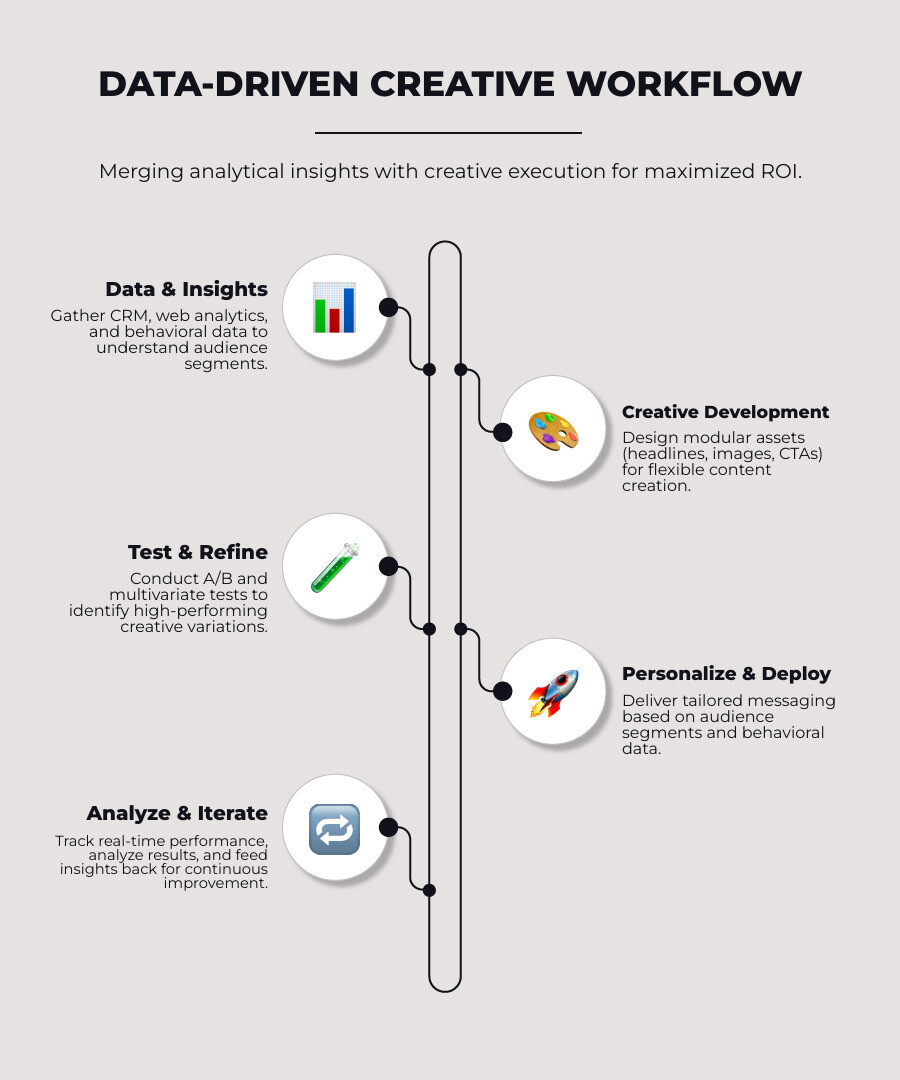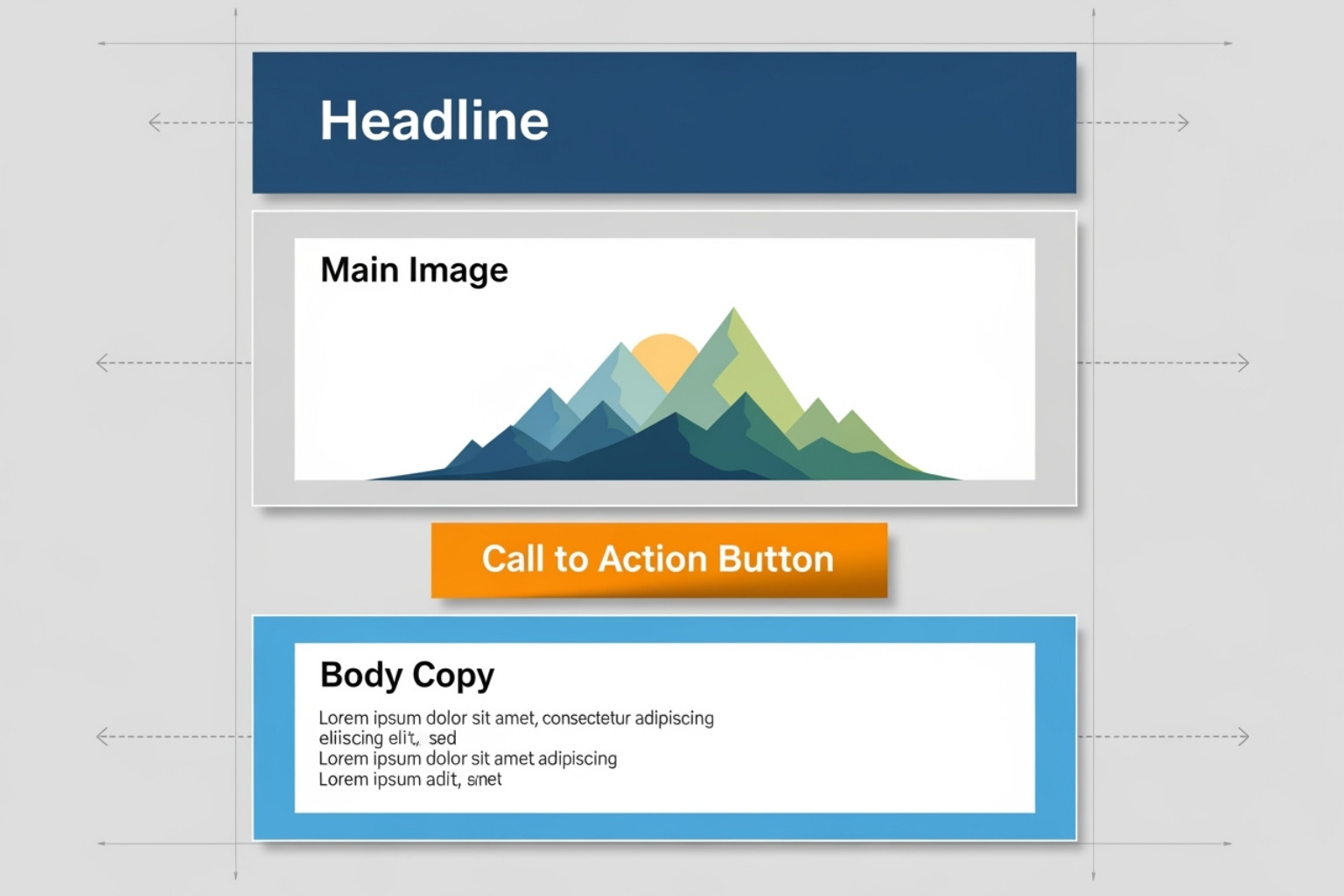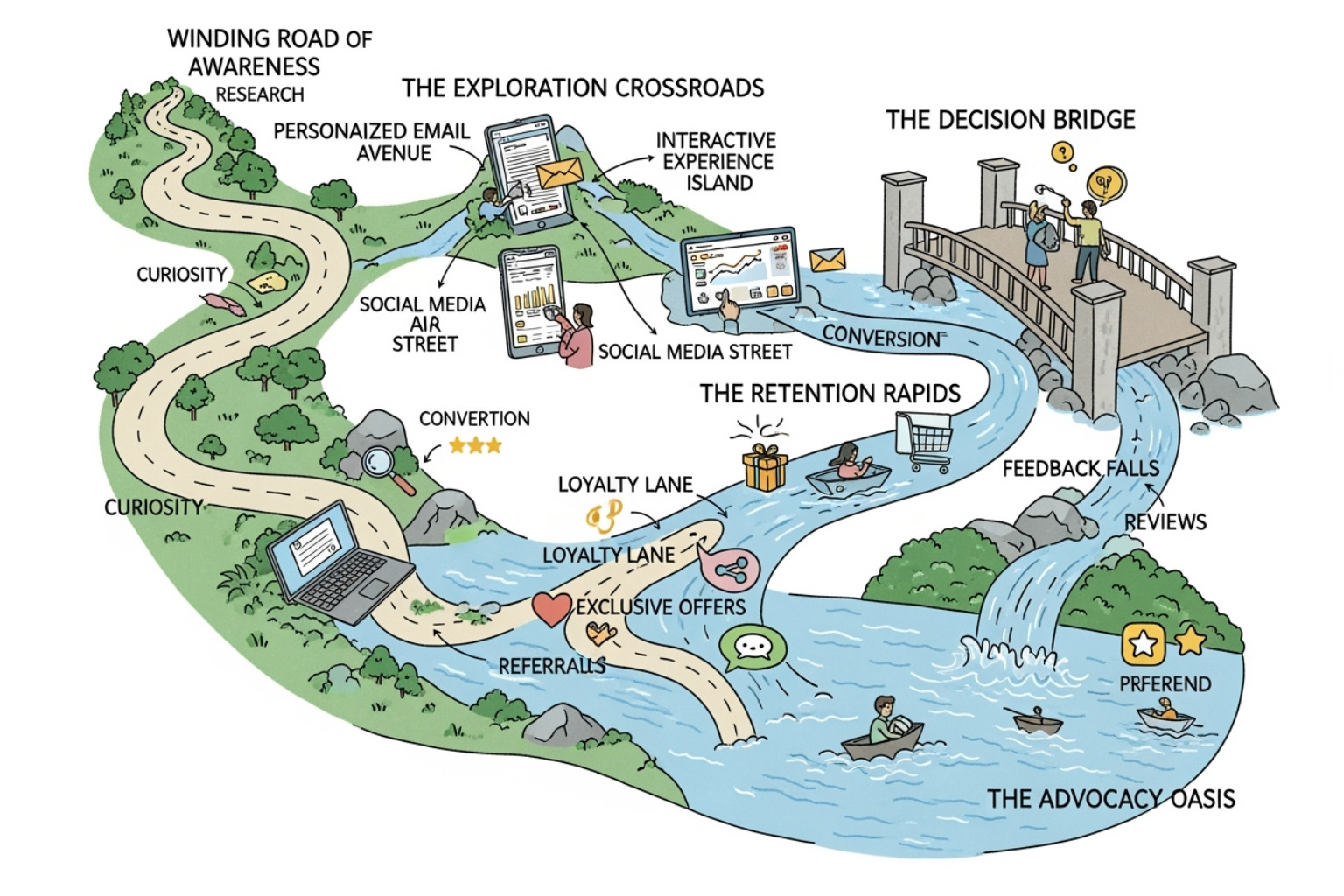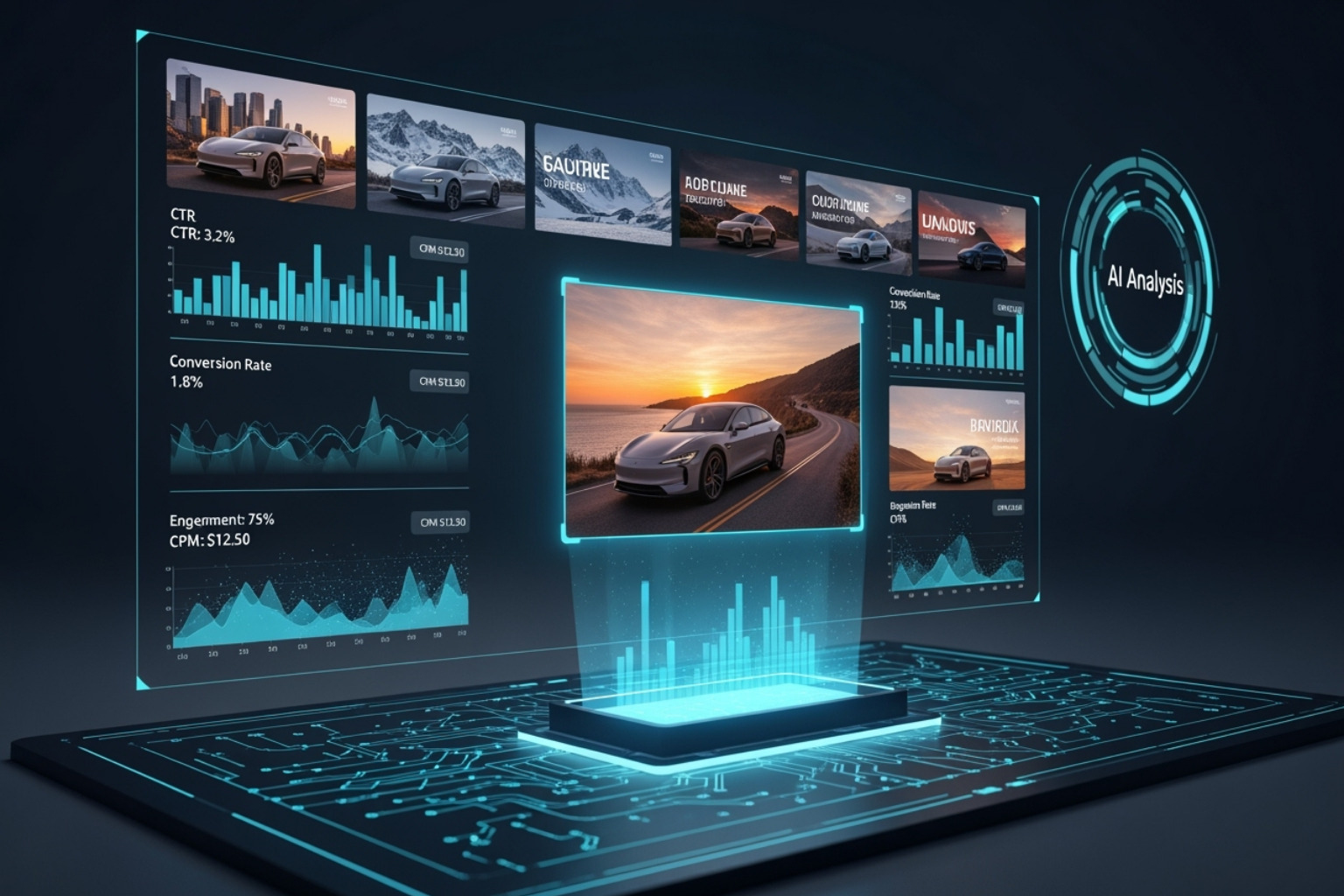The Art of Analytics: Crafting Killer Data-Driven Campaigns
Unlock growth with data-driven creative campaigns. Merge art, analytics, and AI for powerful marketing, personalization, and ROI.
Unlock growth with data-driven creative campaigns. Merge art, analytics, and AI for powerful marketing, personalization, and ROI.

Data-driven creative campaigns combine analytical insights with creative execution to deliver personalized, high-performing marketing that resonates with specific audience segments while maximizing ROI.
Key Components of Data-Driven Creative Campaigns:
The numbers tell a compelling story. Businesses using data-driven strategies drive five to eight times as much ROI as those who don’t. Meanwhile, 71% of consumers expect personalized interactions, and growing companies drive 40% more revenue from personalization alone.
Yet here's the challenge most startup founders face: How do you merge creative intuition with hard data without killing the magic?
The answer lies in understanding that data isn't the enemy of creativity - it's creativity's most powerful ally. When you know exactly what resonates with your audience, you can create more impactful, relevant campaigns that cut through the noise.
I'm Tony Crisp, and I've spent years helping tech companies like Nvidia, HTC Vive, and UC Irvine build data-driven creative campaigns that launch products successfully and drive meaningful growth. Through my work at CRISPx, I've seen how the right blend of analytics and artistry transforms marketing from guesswork into a predictable growth engine.

Data-driven creative campaigns glossary:
The old battle between analytics and artistry is over. Today's most successful marketing merges the two, creating data-driven creative campaigns where analytical insights fuel creative brilliance. Data doesn't kill creativity; it gives it a roadmap to the customer's heart, changing marketing from guesswork into a precision instrument.
The results are undeniable. Businesses using data-driven strategies drive five to eight times as much ROI as those who don't. This approach changes the entire creative process.
| Traditional Creative Process | Data-Driven Creative Workflow |
|---|---|
| Intuition-led concepts | Data-informed insights |
| Broad audience targeting | Segmented and personalized targeting |
| Post-campaign analysis | Real-time tracking and optimization |
| Limited testing | Continuous A/B and multivariate testing |
| Subjective performance review | Objective, data-backed performance metrics |
| "Fire and forget" campaigns | Iterative, adaptive campaigns |
The modern consumer journey involves 20 to 500 touchpoints, and your audience expects a relevant experience at every step. In fact, 71% of consumers expect personalized interactions, and 76% get frustrated when they don't get them. Generic, one-size-fits-all campaigns no longer cut it.
Without data, you're playing marketing roulette, likely burning through your budget on irrelevant ads. Data-driven creative campaigns eliminate the guesswork, helping you understand who your customers are, how they think, and when they're ready to engage. This understanding is your competitive advantage.
A data-driven workflow is a continuous cycle of improvement. It's not a linear path but a dynamic loop that gets smarter over time.
This continuous loop ensures every creative decision is smarter than the last, building institutional knowledge that compounds over time.
Want to dive deeper into leveraging data for smarter marketing decisions? Check out our comprehensive guide on Data Analysis for Marketing.
Building effective data-driven creative campaigns is like constructing a house: you need a solid foundation before you can get creative. This is where strategy, data, and infrastructure come into play.

Our CRISPx LaunchX approach focuses on building this foundation, ensuring every marketing dollar contributes to a cohesive and powerful brand presence. It's about crafting your unique story and setting the stage for campaigns that move the needle. Without this, even the most creative campaigns can feel scattered; with it, you can create magic.
Effective objectives drive results. Start with SMART goals (Specific, Measurable, Achievable, Relevant, Time-bound) to provide a clear target. For example, instead of "increase brand awareness," aim to "boost website traffic from our target demographic by 15% within Q3 using personalized ad creatives."
Your business objectives define the what (e.g., increase market share), while creative objectives define the how (e.g., align creative with conversion rates). As noted by McKinsey, companies with top-quartile ACS scores have clear goals and measure progress against them. This disciplined approach ensures every creative output has a purpose and a measurable impact.
The technical backbone of your campaigns relies on a unified data infrastructure. This doesn't have to be overly complex. The goal is to create a 360-degree customer view to power deep personalization.
Key data sources include:
This infrastructure creates the foundation for gathering and analyzing the diverse data streams that fuel your creative engine.
With a solid foundation, it's time to get creative—strategically. In data-driven creative campaigns, creativity isn't about one perfect ad. It's about building a dynamic system of interchangeable parts designed for continuous improvement.

This modular approach breaks assets into swappable components like headlines, images, and calls-to-action. Think of it like building with LEGOs—you can create countless variations for rapid testing and iteration. This system doesn't kill creativity; it amplifies it by focusing your energy on the elements that matter most.
To build a powerful modular system, you must systematically componentize your creative elements. Deconstruct your ads into their basic building blocks: headlines, hero images, body copy, and CTAs. Each piece can then be optimized independently.
Tagging each element is crucial for tracking, allowing you to understand which headline-image combination performs best for specific audience segments. A centralized component library acts as a creative repository, enabling your team to assemble new ad variations quickly while ensuring brand consistency. While components are interchangeable, your core brand identity and tone of voice must remain solid. Data guides performance, but brand guidelines protect what makes you unique.
This approach is especially powerful for omnichannel marketing, allowing you to generate custom variations that keep audiences engaged and minimize creative fatigue. To learn more about how this strengthens brand strategy, explore our insights on Data-Driven Design.
Testing is the heartbeat of data-driven creative, turning hunches into proven winners. An effective framework moves you from "I think this will work" to "I know this works."
With our modular assets and testing frameworks in place, we're ready to ignite the growth engine. This is where data-driven creative campaigns transform from clever concepts into powerful revenue drivers.

This is the core of our CRISPx OrbitX methodology, which focuses on executing growth marketing with psychology. Sustainable growth comes from understanding what truly motivates people. Data tells us what people do, but psychology tells us why. Combining these insights with personalized creative creates campaigns that build genuine, long-term customer relationships.
For a deeper dive into understanding your audience, check out our resource on Data-Driven Customer Insights.
Personalization is no longer a nice-to-have. 71% of consumers expect personalized interactions, and 80% are more likely to purchase from brands that provide them. True personalization goes beyond using a first name; it means crafting experiences that feel tailor-made by understanding the psychological drivers behind different audience segments.
Effective segmentation uses multiple data lenses:
When people feel understood, they feel connected. Connected customers become brand advocates.
Great campaigns require continuous analysis. Real-time dashboards and attribution models help you understand which creative elements and touchpoints drive conversions. Go beyond purchase tracking to measure micro-conversions like video completion rates, which often predict future behavior.
Key metrics tell the story of your campaign's psychological impact:
This continuous feedback loop of learning and adaptation is what turns data-driven creative campaigns into predictable revenue engines.
Artificial intelligence is rapidly changing marketing, with 93% of marketers believing AI will positively impact their organizations. When integrated into data-driven creative campaigns, AI enables levels of personalization and optimization that were previously impossible, improving quality while reducing effort.

Think of AI as a creative co-pilot. It handles the heavy lifting of data analysis and repetitive tasks, freeing up human talent to focus on breakthrough ideas and emotional connection.
AI and automation can boost creative workflows in several exciting ways:
For more on this, explore Mapping Creative Flows with AI Logic and AI's Impact on Personalization.
The future of data-driven creative campaigns is already unfolding. Key trends to watch include:
The key to success is remembering that technology serves creativity, not the other way around. At CRISPx, we believe in Balancing Creative Freedom with AI Structure to create campaigns that are both data-driven and genuinely inspiring.
When implementing data-driven creative campaigns, several common questions and concerns arise. Here are answers to the three most frequent ones.
The fear that data will kill creativity is common, but it's a misconception. The key is to use data as a creative partner, not a dictator. Data provides the GPS—it tells you which direction leads to success—but it doesn't dictate the journey.
We protect creativity by focusing data on performance elements (e.g., which CTA button color works best) while leaving the core concept, brand voice, and emotional storytelling in human hands. Data can refine a great idea, but it can't replace the initial human spark. Set aside time for pure brainstorming where data takes a back seat, then use insights to optimize those concepts for maximum impact.
Transitioning to a data-driven workflow can present obstacles. The most common challenges include:
Overcome these by starting small to prove value quickly. A successful pilot campaign can secure executive buy-in and demonstrate to the team how data makes their work better. Invest in training or partner with experts to bridge the gap between creative and analytical thinking.
You don't need enterprise-level resources to start. Some of the best data-driven creative campaigns come from scrappy teams.
Consistency and curiosity are more important than complexity. Each small test builds your data-driven muscles and gets your team comfortable with the process.
We've seen that data-driven creative campaigns are not about replacing human creativity with cold numbers. They are about amplifying our ability to connect and inspire with the precision that only data can provide. Data tells us where our audience is, but creativity tells us how to reach their hearts.
The journey begins with building a solid foundation through our LaunchX approach—setting clear objectives and investing in the right data infrastructure. From there, our OrbitX methodology uses psychology and data to execute growth marketing that creates genuine connections, not just clicks.
Looking ahead, AI will continue to amplify our creative capabilities, handling the heavy lifting so we can focus on the human spark that moves people. The key is continuous improvement, learning from every interaction to get a little better with each campaign.
At CRISPx, we've seen this balance transform businesses by building stronger customer relationships and a durable competitive edge. The art of analytics isn't a choice between data and creativity; it's the recognition that they are inseparable partners in creating marketing that matters.
Ready to see what this partnership can do for your brand? Let's explore how our growth marketing expertise can help you connect with your audience on a deeper level. Execute powerful growth marketing with OrbitX.